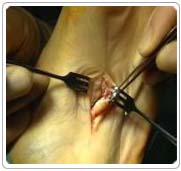What is it?
You have a ganglion on your foot. A ganglion is a swelling that is filled with thick jelly like material. They usually occur on the back of the wrist but they do occur near other joints or near tendons (like in your case where it is in your foot). They usually occur in young adults. It is not known why they occur. In children, ganglions usually disappear without any treatment. This can also happen in adults.
The Operation
You can be given a local or a general anaesthetic. The choice depends partly on which you prefer, and partly on what your surgeon thinks is best.
 Having a general anaesthetic means that you will be completely asleep during the operation. Having a local anaesthetic means that you will be awake during the operation, but will not feel any pain in your foot because the area of the operation will be numbed with an injection. A cut is made in the skin that is at least as wide as the lump. The ganglion is then removed. The skin wound is then closed up with stitches.
Having a general anaesthetic means that you will be completely asleep during the operation. Having a local anaesthetic means that you will be awake during the operation, but will not feel any pain in your foot because the area of the operation will be numbed with an injection. A cut is made in the skin that is at least as wide as the lump. The ganglion is then removed. The skin wound is then closed up with stitches.
By having the operation on your foot you must realise that:
- You will have a scar instead of the ganglion.
- The ganglion will come back in 1 out of 5 patients.
- If you have pain in your foot, this may not be cured by removing your ganglion.
Any Alternatives
You could do nothing and wait to see if your ganglion disappears. The jelly in a ganglion can be removed with a needle and syringe. This is called aspiration. This cures 80% of patients. The ganglion re-fills in 20% of patients. Aspiration of your ganglion is done in the outpatient department. The skin over your lump is cleaned and numbed with a small local anaesthetic injection. The surgeon will suck out as much of the contents of your ganglion as possible with a large needle and syringe. This does not hurt. A sticky plaster is put over the needle hole. You should remove this plaster after six hours. If the hospital has tried curing your ganglion with a needle and syringe and it has returned twice, probably the best plan is to have an operation.
Before the operation
Stop smoking and get your weight down if you are overweight. (See Healthy Living). If you know that you have problems with your blood pressure, your heart, or your lungs, ask your family doctor to check that these are under control. Check the hospital's advice about taking the Pill or hormone replacement therapy (HRT). Check you have a relative or friend who can come with you to the hospital, take you home, and look after you for the first week after the operation. Bring all your tablets and medicines with you to the hospital. On the ward, you may be checked for past illnesses and may have special tests to make sure that you are well prepared and that you can have the operation as safely as possible. . Many hospitals now run special preadmission clinics, where you visit for an hour or two, a few weeks or so before the operation for these checks.
After - In Hospital
Usually the wound is pain-free. You may feel some discomfort. You will be given painkillers to take home. They should easily control this discomfort. After an hour or two on the ward, you should feel fit enough to go home. Before you go, the hospital will:
- Check the wound is comfortable.
- Check the wound is not bleeding.
- Check there is no swelling.
- Give you painkilling tablets to take home.
- Give you a follow-up appointment for 10 days' time or so for a check-up and stitch removal.
- Give you a note to give to your General Practitioner.
- Give you a work certificate, sick note, etc.
- Check you have the ward telephone number.
After - At Home
Make sure a relative or friend can take you home. You should not be by yourself for the first day after your operation. At home, rest. Your foot will be in a bulky bandage when you go home. Your bandage will be taken off and your stitches taken out 10 to 12 days after the operation. You will not need a dressing on the wound after that. Wash around the bandage for the first 10 days. You can wash the wound area as soon as the dressing has been removed. Soap and warm tap water are entirely adequate. Salted water is not necessary. You can shower or take a bath as often as you like once the wound has healed. 24 hours after your operation, your foot should not hurt much.. If you have severe pain, telephone the ward. If you cannot get through to the ward, go straight away to the casualty department of the hospital. You must move your toes regularly. You cannot drive whilst your foot is in the bandage. How soon you can return to work depends on your job. If you can work sitting down, you may be able to return to work two or three days after your operation. This also depends on you being able to get to work. If your job is manual you will be unable to work for three weeks. You may swim and play most sports once your stitches are out. When you start playing, you will not be able to play for as long as normal and your foot may ache at the end of a game.
Possible Complications
As we mentioned, this operation is mostly carried out under local anaesthetic.
If you have the operation under general anaesthetic there is a very small risk for complications related to your heart or your lungs. The tests that you will have before the operation will make sure that you can have the operation in the safest possible way and will bring the risk for such complications very close to zero.
Complications are rare and seldom serious. You can have a minor infection in the area of the operation which can be settled by taking antibiotics for a few days. You may also experience some bruising around the wound which will go away quickly. The ganglion may come back in 1 out of 5 patients. The skin around the scar may be permanently numb after your operation.
Advanced Reproductive Technology
- In Vitro Fertilisation (IVF)
- Intracytoplasmic Sperm Injection (ICSI)
- Donor egg and embryo programs
- In Vitro Fertilisation (IVF)
- Pre-implantation genetic diagnosis (PGD)
- Surrogacy programs
Dental Videos





